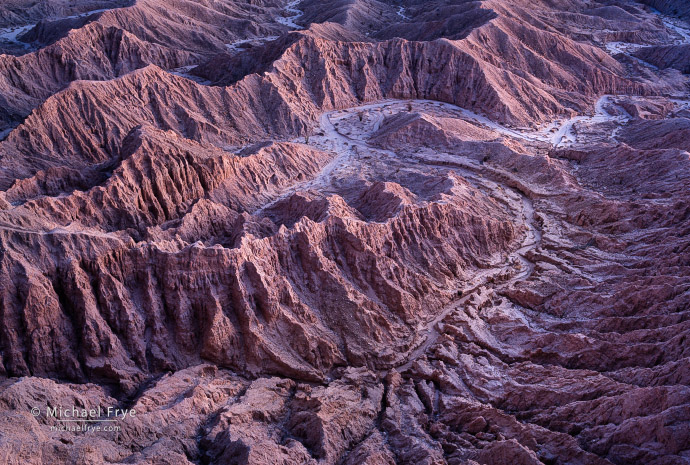
Twisting wash, badlands, Southern California. The curvy lines of the wash and surrounding ridges created a design I could build a composition around. Soft sidelight from the post-sunset glow brought out the forms and textures of the land, without the harshness of direct sunlight.
In late March Claudia and I joined photographer friends in the deserts of Southern California. We enjoyed just hanging out together, but I also got to visit some badlands areas I’d never photographed before, which was lots of fun.
To me, photographing badlands is similar to photographing sand dunes. Both have acres of naked earth, sculpted into interesting shapes and forms by either wind or water. With badlands the shapes are more angular than in dunes, but you can find great designs in both environments.
And design is what it’s all about. One of the best ways to improve your compositions is to not think about composing a scene, but rather think about designing the photograph. In other words, look at the lines, shapes, and patterns in the scene or subject in front of you, and think about how you can arrange those elements to create a design within the frame.
In the photograph above, for example, what attracted me to this view was the twisting line of the wash, and the corresponding twists of the fluted ridges surrounding the wash. It’s a vivid display of erosion at work. It’s also a strong, eye-catching design, something I could build a composition around. Once I saw this, I just had to figure out where to stand – what spot would best display the arrangement of lines and shapes below – and exactly where to place the edges of the frame to emphasize the curving lines.
This next photograph is all about repeating horizontal layers. There’s lots of variation in those layers, which, I think, makes things more interesting. With patterns, I’d like to have enough similarity between repeating lines or shapes to get a sense of repetition and rhythm, but enough variation to keep the viewer’s eye and brain engaged:
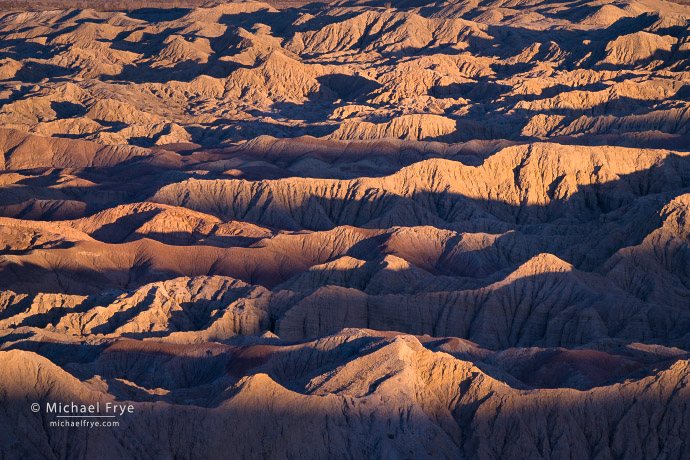
Badlands layers, Southern California. The light created a pattern of light and dark that lasted just a couple of minutes.
Here the light skimming across the ridges creates the layers of light and dark, and makes the pattern. This would have looked different a minute or two earlier or later.
Light and composition obviously go together. Sometimes light creates designs, as in this photograph. Sometimes light might help emphasize design, form, or texture, as in the photograph at the top of this post with its soft, sidelit, post-sunset glow. Light itself can sometimes be the main subject of a photograph. At the very least, light determines what objects draw the eye, and how your eye moves through the frame, which is always a key consideration in any composition.
I find that the same light that works with dunes usually works with badlands, including low-angle sunlight, and a pre-sunrise or post-sunset glow. That soft glow before sunrise or after sunset is my favorite for both badlands and dunes. It can be directional, bringing out the forms and textures of the earth, but without the harshness of direct sunlight. And very early or late, on clear days, dunes or badlands can glow orange or pink, reflecting the color of the pre-sunrise or post-sunset sky – something you can see in several of the photographs here.
To me, the badlands are anything but. They may be barren of vegetation, but they’re fertile terrain for photography, where the elemental forms of the earth can create beautiful designs.
— Michael Frye
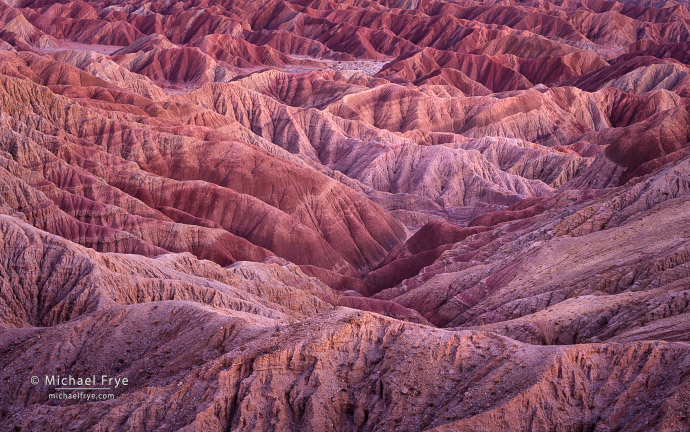
Diagonal ridges, badlands, Southern California. I noticed this zigzag pattern in the ridges, and used a telephoto lens (132mm) to fill the frame with that pattern. Soft, post-sunset light was the perfect complement to this scene.
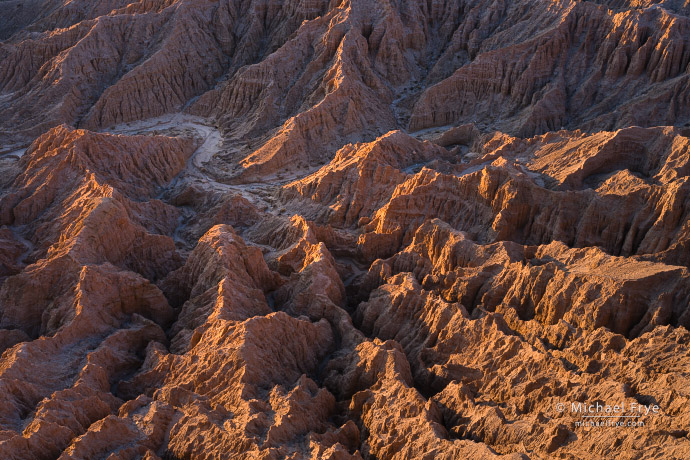
Sunrise light on badlands, Southern California. The first rays of sunlight emphasized the converging lines of the ridges.
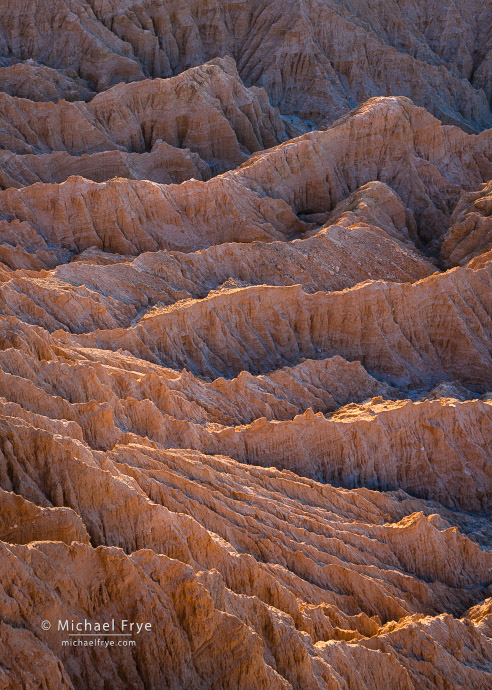
Badlands ridges, Southern California. Another pattern, with backlight delineating successive layers.
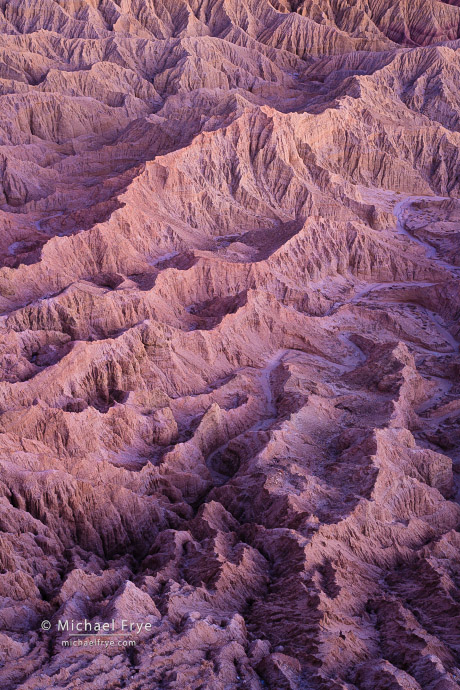
Eroded ridges, badlands, Southern California. To me, the design here is formed by lines radiating out from the small peak above center. Again post-sunset light cast a lovely pink glow onto the badlands.
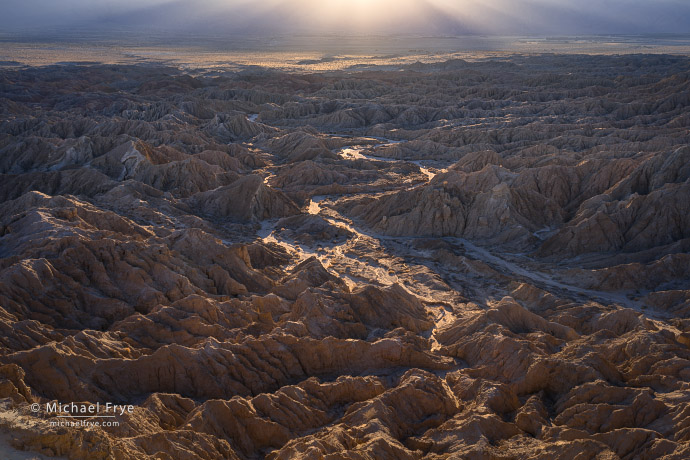
Zigzag wash, late afternoon, Southern California. The wash twisting through the badlands provided a focal point and a design element. Just before the sun dipped below a ridge to the west it created sunbeams in the dusty atmosphere, while backlighting the wash and badlands. It was a challenge to shade the lens to prevent flare, yet still keep my hand out of the picture.
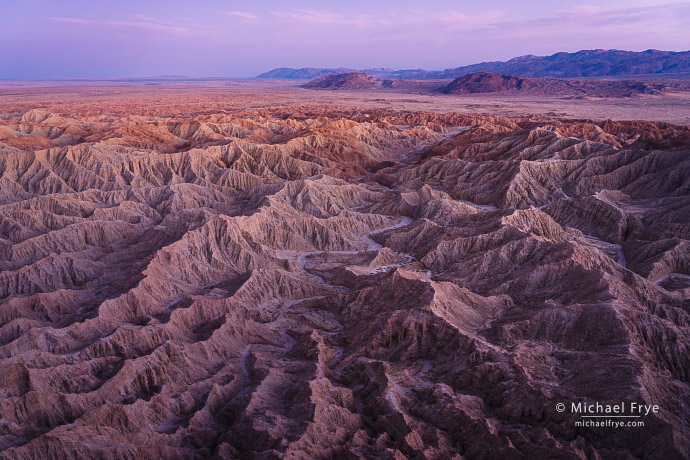
Dusk light, badlands, Southern California. This image is less abstract than some others in this set, but there’s still a design, with converging diagonals in the foreground leading the eye into the distance.
Related Posts: Desert Designs; Patterns, Focal Points, and Flowers
Michael Frye is a professional photographer specializing in landscapes and nature. He lives near Yosemite National Park in California, but travels extensively to photograph natural landscapes in the American West and throughout the world.
Michael uses light, weather, and design to make photographs that capture the mood of the landscape, and convey the beauty, power, and mystery of nature. His work has received numerous awards, including the North American Nature Photography Association’s 2023 award for Fine Art in Nature Photography. Mich
ael’s photographs have appeared in publications around the world, and he’s the author and/or principal photographer of several books, including Digital Landscape Photography: In the Footsteps of Ansel Adams and the Great Masters, and The Photographer’s Guide to Yosemite.
Michael loves to share his knowledge of photography through articles, books, workshops, online courses, and his blog. He’s taught over 200 workshops focused on landscape photography, night photography, digital image processing, and printing.







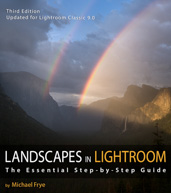
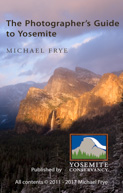
Really nice article and accompanying photos Michael. I too love photographing badlands. They are so visually interesting. You have such a way of making the best use of the available light.
Thank you Ted! Light is so vital.
I always look forward to reading your emails. You are as generous with sharing your helpful techniques as your photos are gorgeous! Thank you so much for sharing–God bless you always!
Thanks very much Ann!